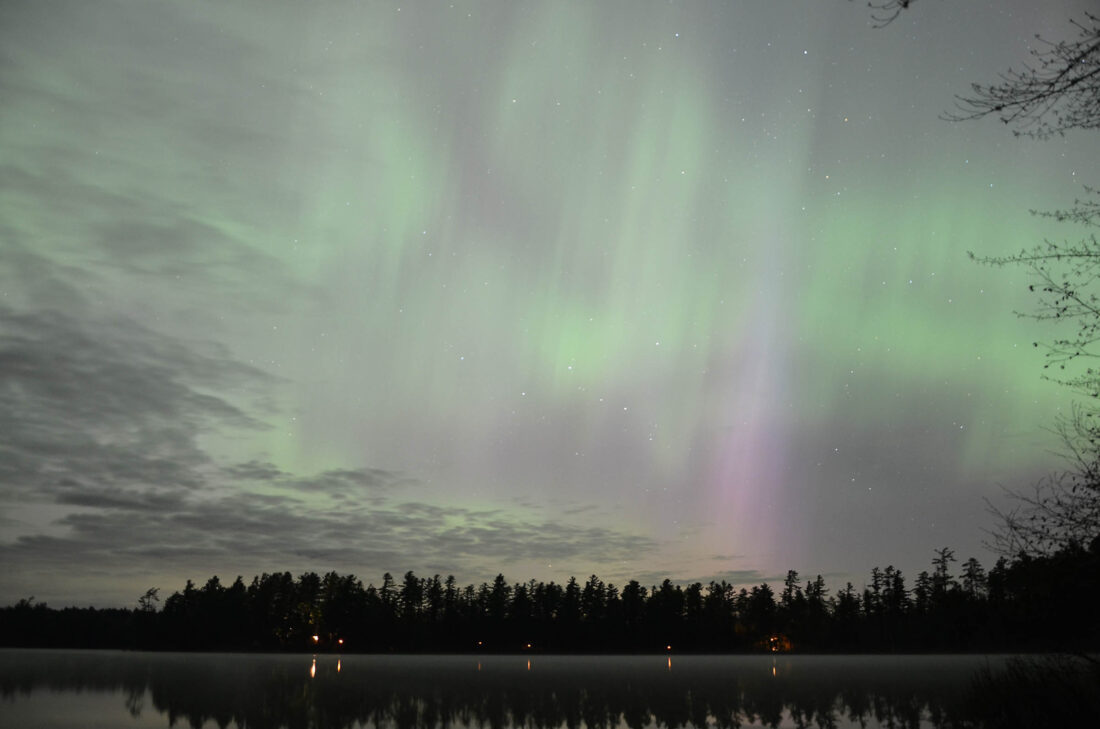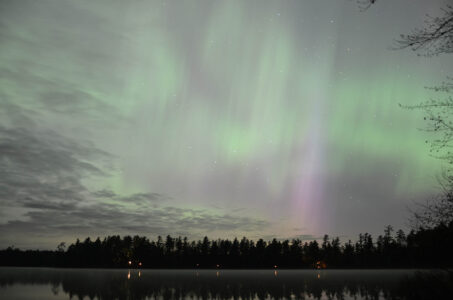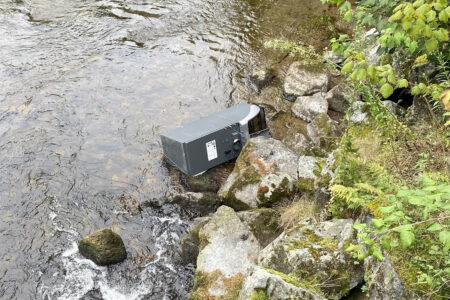Outside chance of northern lights tonight as skies clear

The northern lights illuminated the midnight sky in May 2024, seen here from Osgood Pond. Energetic particles shot from the sun during a solar storm collided with gases in Earth’s atmosphere, turning the sky green and making columns of light dance overhead. Cameras with long exposure times capture the light more fully, but with patience, waves of these particles crashing through the sky could be seen cruising overhead at millions of miles per hour. (Enterprise photo — Aaron Marbone)
TUPPER LAKE — The Adirondack dark skies are among the most pristine in the eastern U.S. for viewing stars, galaxies and other astronomical wonders. Tonight, there may be a chance locally to catch a glimpse of a phenomenon typically reserved for the far northern latitudes: Aurora Borealis, also known as the northern lights.
Satellites watching the sun detected a coronal mass ejection (CME) on Saturday, with the energy responsible for the northern lights heading toward Earth. The energy arrived at Earth’s atmosphere late Monday, beginning the potential for the northern lights. Although last night presented the best chance of seeing them, persistent high clouds from a coastal low-pressure system were expected to all but shut the door, according to forecasts available at press time Monday.
While the CME energy is diminishing throughout the day, it’s difficult to predict how long the chances of seeing the northern lights will linger. That’s largely determined by the CME energy’s magnetic orientation and intensity, which cannot be reliably determined until its energy passes by a NASA satellite located about 1 million miles from Earth, and often less than an hour until the energy reaches Earth.
The satellite can pick up on CMEs as they occur on the sun — located about 93.8 million miles from Earth — but this only offers preliminary information, such as what direction the energy is traveling in, and approximately how strong the energy will be. Once the leading waves of energy arrive at the satellite, its sensors can get a more definitive sense of the CME’s energy and, correspondingly, how strong and far south the northern lights will reach.
If the CME energy’s magnetic orientation ends up pointing south, it matches Earth’s northward magnetic orientation, resulting in a stronger northern lights display as the particles flood into the outer levels of the atmosphere. On the other hand, if the CME’s magnetic orientation points north and away from the Earth’s, it gets deflected, minimizing the northern lights display.
The coloration that’s visible to the human eye comes as those CME particles interact with various gases in the atmosphere, according to Marc Staves, one of the founding members and astromers at the Adirondack Sky Center & Observatory.
“Once it impacts the upper atmosphere, the ionosphere and the magnetosphere, it perturbs our magnetic field,” he said. “And those charged particles that get released with that plasma interact with gas that’s in our atmosphere.”
Staves said that typically, people will see green. That’s from oxygen, and its relatively greater abundance at lower levels of the atmosphere makes the light easier to see. Staves said that other colors are more common during the higher intensity solar storms when other gases are more readily lit up by the CME energy.
“If you have a really intense storm, it can start interacting with those particles higher in the atmosphere, and that’s when we start seeing those different colors occur,” he said. “The reds, the pinks, the blues — each of those colors represents a different type of gas in the atmosphere. That’s what causes the different colors.”
When it comes to trying to spot the northern lights, Staves said serendipity is your friend.
“It really depends on the intensity of the storm that’s impacting Earth’s atmosphere at the time,” he said. “It can be fleeting, it can last for minutes, it can last for hours.”
In order to maximize the chances of seeing them, Staves said to find a spot far away from any street lights or other ground sources of light emission. Additionally, the ideal viewing spot should have a wide opening up into the sky, particularly one that faces north.
Staves said many smartphones come with a nighttime mode that automatically sets the parameters to capture the night sky. For more advanced cameras, he recommended a high ISO setting, an f-stop of 2.8 and an 11-16 mm lens.
“Nice and wide and wide open,” he said. “You have to collect a lot of light in a relatively short period of time.”
Before heading out the door, the last — and crucial — factor to check is the weather. Even the most spectacular northern lights displays are no match for a bank of clouds. As of press time Monday evening, the National Weather Service’s Burlington, Vermont office, which serves the Tri-Lakes region, was predicting partly to mostly clear skies tonight, with about 40% cloud cover to start the evening and diminishing as the night goes on.
Even if tonight ends up being a dud, there may be more chances down the road. That’s because the sun is currently near the peak of its 11-year cycle, where its magnetic poles flip direction. This tends to result in more active solar storms that have the potential to produce more CMEs.
“We’re going through that period right now where the sun’s very, very active,” Staves said.
To view the latest northern lights forecast from NOAA’s Space Weather Prediction Center, visit tinyurl.com/yr475xkp.



